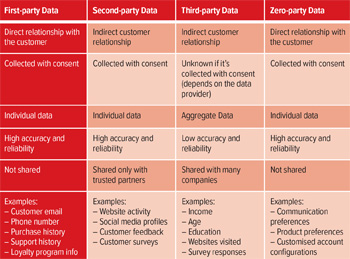
The last issue of InPublishing had an informative interview with Philip McMullan, head of audience and data at the Evening Standard. In it, the case for the importance of first party data strategies was clearly outlined, as was the importance and value of trusted content.
In the article, McMullan argued effectively for data to be gathered in “a secure and privacy compliant way, to ensure audiences understand the value transaction”. This is clearly sensible and important in a world were successful media brands build trust and loyalty with their audiences, but not all first party data is about the ‘value transaction’.
To understand this apparent contradiction, it is important to understand what first party data is, why it has come back to centre stage, why media owners can benefit from it, and how it can be used to commercial advantage.
Before the rise of the ad networks and programmatic buying, most quality brand media was purchased on a very particular contextual signal. Even if the market didn’t call it that! Back then, ‘context’ was code for a publication’s brand, and the audience that brand attracted.
The open access philosophy of early internet media businesses, before the rise of meter and paywalls, laid the foundations for a shift of focus from specific media brand audiences to a more generic view of size; bigger was better as poor metrics like ad impressions drove strategy and advertiser spend.
This inevitably led savvy advertisers to want more metrics to help target and improve the effectiveness of media spend and ROI, and the solution they all fixated on was third party data strategies, combined with ad tech and third party cookies to build their own super audiences independently of brands and media owners.
In a pre-GDPR world, this put media owners at a severe disadvantage. Post-GDPR, the demise of the third party cookie and an increased focus across the media world on a move from ‘unknown’ to ‘known’ audiences and first party cookies, has put first party data strategy on everyone’s radar.
The term ‘first party data’ means something different for every media owner, but, as the third party cookie-less world beckons, it’s becoming clear that publishers, and first party audiences are becoming more valuable, as data, harvested without the user’s knowledge from third party cookies, is no longer a legal, viable or acceptable method of tracking and targeting users.
More importantly, moves from all the main browser owners, combined with GDPR legislation, and more awareness from consumers about privacy and its digital implications means publishers are now holding most of the cards.
But what exactly is first party data in the context of publishing?
The most valuable form of first party data for publishers is their audience.
Audience data
The most valuable form of first party data for publishers is their audience: the users who visit and engage with their web properties. It is essentially anything you know about your audience: demographic and firmographic details like name, company, age and job title, contact details such as email address or postcode and personal information such as age, gender, or, increasingly, gender pronouns, and household income.
In the digital world, this traditional data is super powered when combined with behavioural, transactional and preference data.
Most media owners have been collecting this type of behavioural, transactional and preference first party data for a long time with analytics or BI tools to track user interactions such as:
- On-site activity (analytics)
- Newsletter metrics (subscriptions, open rates, clicks)
- On-site searches or inbound searches
- Content consumption and trends
- Transactional information such as downloads or voting behaviour
- Using IP addresses to identify visiting companies
- Device detecting to help optimise the user experience
As McMullan said in the last issue, it is essential that the consent of the audience is given before any of this data is collected and its potential usage is made clear to that audience.
Many B2B media owners, unlike their B2C compatriots, chose an initial ‘legitimate interest’ position for GDPR compliance. But with this focus on first party data and the commercial options it opens, most are moving, or have moved to ‘consent’ as the best GDPR approach.
This levelling of approach is also important as it helps commercial partners understand the media offering and landscape better. More importantly, it focuses attention back on audience. It is now not about size, but the quality! Large circulations are less valuable now, but are necessary to build custom audiences or segments, which now command higher prices and value for all parties.
It is now not about size, but the quality! Large circulations are less valuable now.
Consent management
This is where the burgeoning number of Consent Management Platforms (CMPs) OneTrust, Quantcast or TrustArc, join the story. These cookie consent pop-ups and user agreement tools are powerful because they essentially allow the monetisation of first party audience data in a fully compliant and transparent way. It is vital that publishers make consent requests clear and concise, using non-technical language, explains why their data is being collected and how it is going to be used, allowing them to opt out if they change their mind.
The value proposition part is harder to convey. It is easy to list and explain the nature and purpose of different types of first party cookies such as ‘essential’, ‘functional and customisation’ and ‘advertising’ or ‘social’ but how they holistically fit into the overall strategy is not so explicit.
More awareness from consumers about privacy and its digital implications means publishers are now holding most of the cards.
User centric
Media and marketing is now user centric and personalised. Understanding who users are, what content they are consuming, on which devices, when in the day, and where and why is now at the heart of every media strategy and is much more sophisticated and linked to ROI than it was even five years ago.
This user centricity is based on behaviour and increasingly is using segments to break the overall audience into more specific, targetable valuable groups, both for commercial partners or the publishers themselves to target and monetise in different ways.
Different media owners will have different considerations about first party data. For B2C, size of audience and knowledge of it must be balanced with the commercial reality of a competitive ad market where volume and reach are still a significant currency, regardless of subscription revenues. For B2B, the consideration is focused on reach and market coverage, not volume of users or impressions; in essence, a narrow and deep knowledge of users which is at odds with the values of a third party, volume driven buy.
In the digital world, this traditional data is super powered when combined with behavioural, transactional and preference data.
Unknown to known
Regardless of size or type of audience, all publishers can and are increasingly using segments. The simplest segmentation is ‘known’ and ‘unknown’.
The known audience are those who have either registered for free or paid for a subscription. Here, email is the main identifier and traditionally demographic and firmographic data would be used to make data selections to target known users either with advertising through topic specific newsletters or offers for event attendance or subscription packages based on company type and role.
The unknown audience are obviously those who visit but have not handed over any first party demographic or firmographic data. An effective first party strategy can add more value to these users though lookalike modelling and behavioural tracking through the use of marketing automation tools.

Lookalike modelling is a process that identifies people who look and act just like your target audiences. Typically, this is focused on identifying known user behaviour by using data collected at registration, such as company size, type or job role, then using these data points combined with behavioural and usage data to predict what type of unknown user they are.
An example might be identifying typical content behaviours of a marketing director, or a topic newsletter registrant, using the real-time behaviour of a known user. With the first party data collected, pop-ups can be fired to encourage a registration for a specific event, or to download a document or present a tailored subscription offer.
The overarching objective of this approach is to move as many users as you can from ‘unknown’ to ‘known’ as this provides more targeting opportunities both through email or push notifications (outbound marketing) or on site advertising, pop-ups or content (inbound marketing).
Combining first party data sources in this way opens new and valuable commercial and marketing possibilities, particularly if combined with automation rules, using behavioural first party data. A behavioural segment is rules based, such as: “someone that has done this and/or not done that, and/or seen this over this time period”.
So, a use case would be: identify users who have hit a registration wall, and who are not registered, and have done this twice in two months. Or, in plain language, an unregistered user who has been asked to register twice in two months but has not done so.
The automation rule that would then be triggered would be, “once the user returns, start showing these users this, over this period to try to get them to do that”. In this example, the use case would be, fire a pop-up to these users, offering a free download in return for a registration. If combined with lookalike modelling, a further sophistication could be added to offer a particular download for marketing directors and a different one for buyers.
From an advertising point of view, creating such targeted segments around behaviour creates addressable audiences for advertisers. Such granular targeting has a value and commands a higher CPM because it is cutting out wastage and making ROI on campaigns much more compelling. It is also highly attractive to advertisers as an alternative to Facebook and Google, making it more likely that ad spend can move from the demand side (DSPs) to the sell side (SSPs) and bring this revenue back to publishers, making it available as second party data.
It is important that all publishers, large or small, start thinking this way. It is an extension of how good media owners look to target and grow revenue though spotting and converting opportunities into revenue. Most importantly, it is harvesting information from your own network, and if used effectively, presents more targeted content offers and adverts to users, increasing loyalty and trust in the brand.
Such granular targeting has a value and commands a higher CPM because it is cutting out wastage.
Checklist
- Move to a GDPR position of ‘consent’ over ‘legitimate interest’.
- Use a Consent Management Platform (CMP) to ensure first party audience data is collected in a fully GDPR compliant way and consent is transparent, allowing a user to change preferences at any time.
- Focus on converting users from ‘unknown’ to ‘known’, through registration or paywalls, to build value in your target audience.
- Use known data to create lookalike models to target and convert unknown user, with specific offers.
- Look to segment your audience into valuable subgroups using behavioural, transactional and preference first party data.
- Use automations to create rule-based targeting to deal with specific objectives such as registration, subscriptions or lead generation, and combine this with segment targeting.
- It is never too late to start.
- Experiment, fail fast and iterate.
Media and marketing is now user centric and personalised.
This article was first published in InPublishing magazine. If you would like to be added to the free mailing list, please register here.












